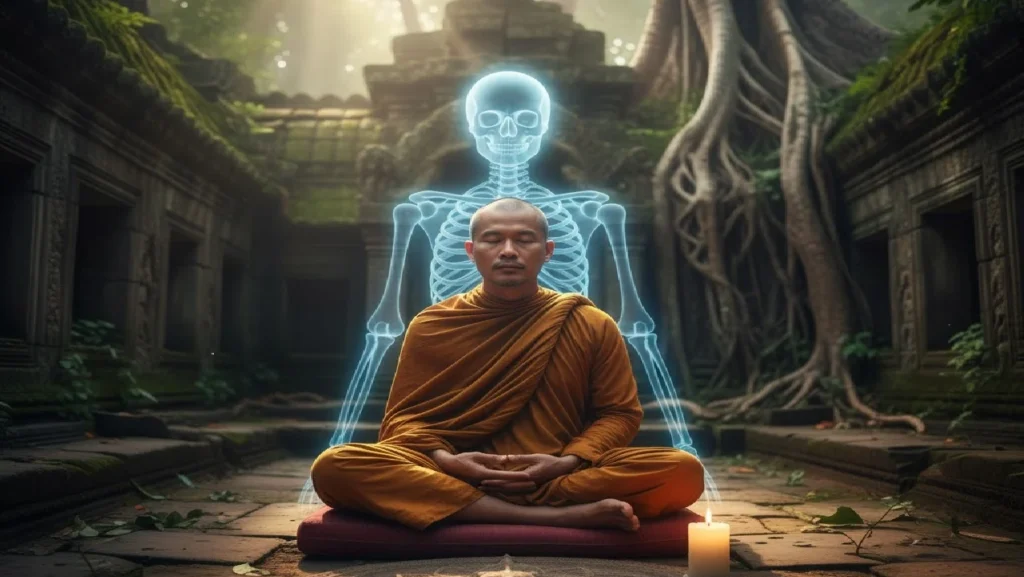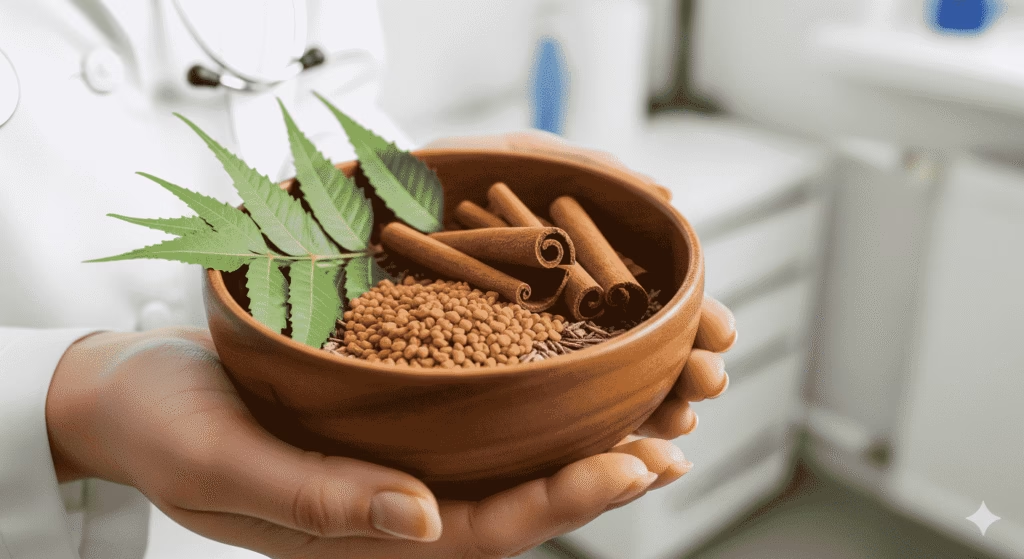Ayurveda, derived from the Sanskrit words “Ayu” (life) and “Veda” (knowledge), literally means “The Science of Life.” Originating over 5,000 years ago in the Vedic culture of India, Ayurveda is one of the oldest comprehensive healthcare systems in the world. It emphasizes holistic wellness by balancing the body, mind, and spirit through natural means. Central to Ayurveda are foundational principles that explain the nature of existence, health, and disease. This article explores those core Ayurveda principles, including the relationship between the Gunas, Tatvas, Doshas, and Prakriti—fundamental concepts that underlie Ayurvedic philosophy.
Origins & Cosmic Foundations of Ayurveda
According to ancient philosophical perceptions, existence began as an unmanifest, undivided life-force—pure potential and wholeness. All was One, unified without differentiation. Within this whole, two fundamental principles co-exist:
- Purusha (male): The eternal, unchanging, conscious principle—pure awareness. It is nirguna—without qualities or gunas—and acts as the silent observer or witness of all creation.
- Prakriti (female): The creative matrix or primordial nature, saguna embodying sattva, rajas, and tamas—the three gunas or fundamental qualities that govern all physical and mental phenomena in the universe.
Prakriti, with its three gunas, is the source from which the manifest world arises, while Purusha is the unchanging consciousness that illumines and witnesses this manifested existence.
From the interaction of Purusha and Prakriti emerged AUM, the eternal cosmic sound, which vibrated to create Primordial Matter. Influenced by the interplay of the gunas within Prakriti, this vibration unfolded into the Five Great Elements (Pancha Mahabhutas):
- Space (Akasha): First manifest, with Sattva as its dominant guna, offering expansiveness and the primary field for differentiation and movement.
- Air (Vayu): Born from the movement within space, dominated by Rajas, embodying dynamism and activity.
- Fire (Agni): Created by the friction of movement; a blend of Sattva and Rajas, responsible for transformation, heat, and light.
- Water (Jala): Formed from the liquefaction caused by Fire; a combination of Sattva and Tamas, conveying cohesion and fluidity.
- Earth (Prithvi): Resulting from condensation of Water, dominated by Tamas, imparting solidity, structure, and stability to all creation.
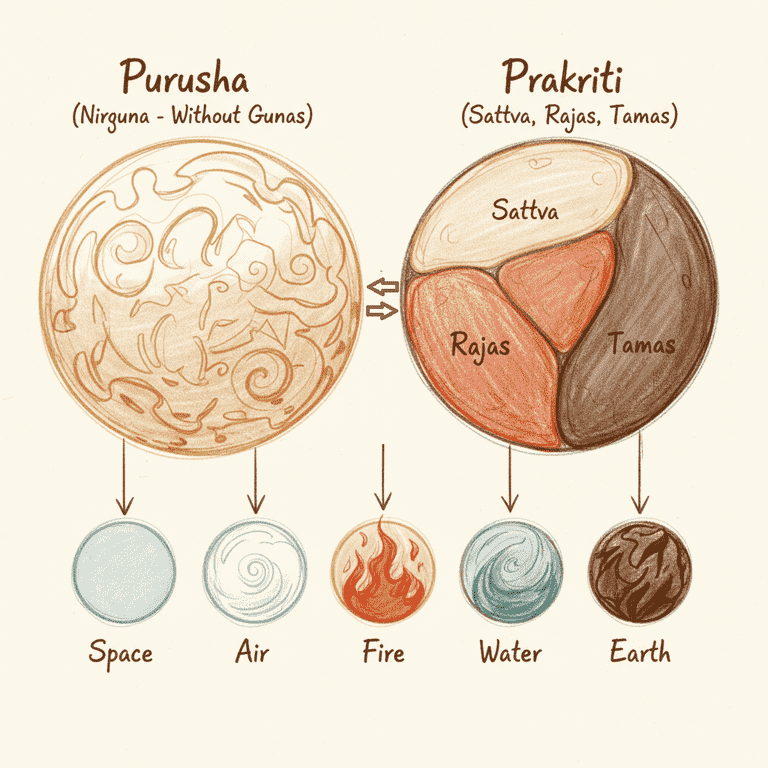
with three gunas- sattva, rajas and tamas
to form 5 elements-space, earth, fire, water & earth
Thus, the cosmos unfolds as a dance between the unmanifest witness (Purusha) and the manifest nature with its three Gunas (Prakriti). All creation, including human beings as microcosms, is composed of these Five Great Elements, each shaped by the quality of the gunas.
Foundational Ayurveda Principles
1. Trigunas: The Three Qualities of Nature
Ayurveda recognizes the significance of the mind and emotions in human well-being. This tradition understands the subtle dimensions of mental and emotional health through three fundamental qualities known as the Gunas:
- Sattva: embodies purity, balance, and clarity—the force of harmony and potential for awakening.
- Rajas: signifies energy, movement, and transformation—driving activity and change in the cosmos. Linked with ambition and desire.
- Tamas: represents inertia, solidity, and cohesion—imparting structure, stability, and the capacity for rest.
These Gunas operate at the mind and subtle levels, affecting thoughts, emotions, and behavior.
2. Panchamahabhutas: The Five Great Elements (Tatvas)
Ayurveda believes that the entire universe, including the human body, is composed of five basic elements called Panchamahabhutas or Tatvas:
- Akasha (Ether/Space): The subtle space that allows movement and sound.
- Vayu (Air): Represents movement and vitality.
- Teja (Fire): Responsible for transformation and metabolism.
- Jala (Water): Governs fluidity and cohesion.
- Prithvi (Earth): Provides solidity and stability.
These elements combine in different proportions to create the material world, including the human body. They explain physical structures and physiological processes through their presence and interactions.
3. Tridosha: The Three Vital Energies
Derived from the Panchamahabhutas, the Tridoshas are dynamic functional energies that regulate all physical and mental processes:
- Vata (Space + Air): The principle of movement, responsible for circulation, respiration, nerve impulses, and elimination. It embodies change and mobility.
- Pitta (Fire + Water): The principle of transformation, governing digestion, metabolism, body temperature, and enzymatic activity.
- Kapha (Water + Earth): The principle of structure and lubrication, providing stability, strength, and immunity.
4. Prakriti: The Unique Constitution
Every individual has a unique combination of the Doshas called the Prakriti, which shapes physical attributes, personality, and susceptibility to disease. Health is viewed as the harmony and balanced functioning of these Doshas, while their imbalance leads to disease.
Ayurveda classifies Prakriti into seven main types:
- Vata Prakriti: Slim body frame, dry skin, light sleep; creative and energetic but prone to anxiety, restlessness, and digestive issues.
- Pitta Prakriti: Medium build, sharp intellect, strong appetite; ambitious and confident but prone to irritability, acidity, and skin disorders.
- Kapha Prakriti: Strong and stable body, calm mindset; compassionate and steady but prone to weight gain, lethargy, and respiratory issues.
- Vata-Pitta Prakriti: Lean, energetic, creative, and sharp-minded but may suffer from digestive disturbances, anxiety, and irritability.
- Pitta-Kapha Prakriti: Strong, determined, good stamina; balanced metabolism but at risk of cholesterol imbalance, inflammation, and obesity.
- Vata-Kapha Prakriti: Variable body structure with alternating vitality and sluggishness; prone to respiratory issues, joint pain, and poor digestion.
- Sama Dosha (Balanced Constitution): Ideal equilibrium of Vata, Pitta, and Kapha; balanced body, stable digestion, calm mind, and strong immunity. Considered the healthiest constitution but rare.
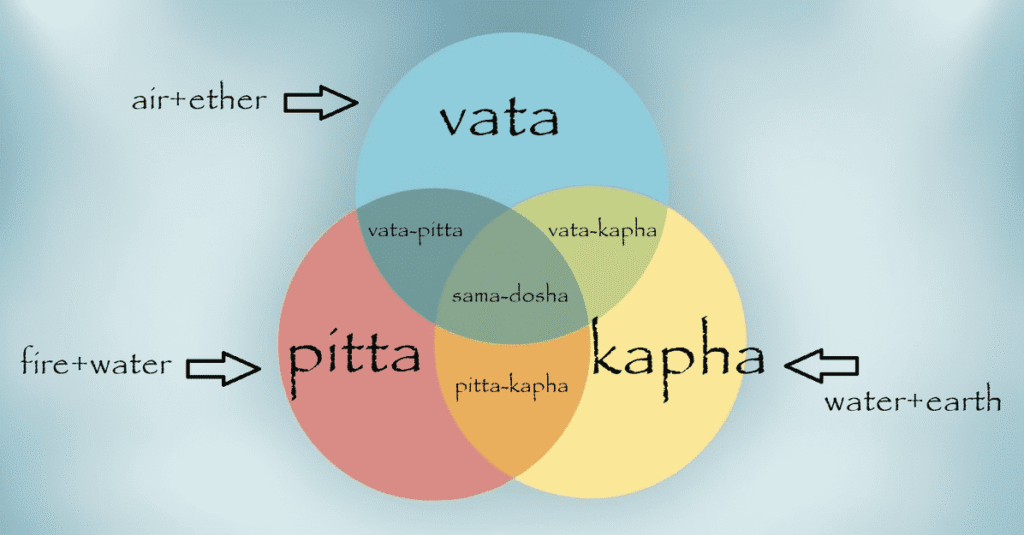
5. Saptadhatus: The Seven Body Tissues
The human body is nourished and sustained by seven fundamental tissues called Dhatus, each with specific roles in growth, repair, and overall vitality:
- Rasa (Plasma): Nourishes the entire body and supports circulation.
- Rakta (Blood): Sustains life, carries oxygen, and supports vitality.
- Mamsa (Muscle): Provides strength, form, and movement.
- Meda (Fat): Lubricates tissues and maintains energy reserves.
- Asthi (Bone): Gives structure, stability, and support to the body.
- Majja (Bone Marrow/Nervous Tissue): Fills bones, supports immunity, and forms the nervous system.
- Shukra/Artava (Reproductive Tissue): Maintains reproductive capacity and vitality.
Proper nutrition and a balanced Agni (digestive fire) ensures the sequential nourishment of these tissues, thereby sustaining health.
6. Malas: The Three Waste Products
Normal body functioning also depends on the proper formation and elimination of Malas (waste products). There are three primary Malas described in Ayurveda:
- Purisha (Feces): Solid waste eliminated through the intestines; maintains balance of Vata and digestive system.
- Mutra (Urine): Liquid waste that regulates water balance and removes toxins.
- Sveda (Sweat): Waste product of fat metabolism; regulates temperature and maintains skin health.
Balanced elimination of these Malas is considered as essential to health as the formation of Dhatus, since their retention or abnormality is regarded as a source of disease.
7. Subtle Forces: Agni, Ama, Ojas
Agni
Agni—“digestive and transformative fire”—is at the core of health. It governs all metabolism, digestion, and cellular transformation. If Agni is strong and balanced, nourishment is complete, and tissues are healthy.
Ama
If Agni becomes impaired, digestion falters and food is not completely transformed. This creates Ama, a sticky, heavy, foul substance that begins in the gastrointestinal tract and can spread to other bodily channels, blocking the flow of energy, nutrition, and subtle forces. Ama is the root of most modern chronic and immune-related diseases, according to Ayurveda. Clearing Ama and rekindling Agni are thus foundational therapeutic goals.
Ojas
Ojas is the subtle essence produced by healthy digestion and the proper nourishment of all tissues. It represents vitality, immunity, stability, and resilience of body and mind. Ojas can be diminished by stress, excessive stimulation, poor diet, aging, and certain diseases, and restored by deep rest, meditation, sexual moderation, fresh foods, and certain herbs (e.g. ashwagandha, shatavari, saffron). High Ojas confers robust health and graceful aging.
The cycle of Agni, Ama, and Ojas
These three concepts are locked in a continuous, interdependent cycle:
Strong Agni creates Ojas: When your digestive fire is strong and balanced, it fully processes food, leading to the creation of high-quality Ojas, which boosts immunity and vitality.
Weak Agni creates Ama: When your digestive fire is weak, it leaves behind undigested food that ferments and becomes toxic Ama, which leads to sickness.
Ama obstructs Ojas: Ama actively clogs the body’s channels, disrupting nutrient flow and ultimately diminishing the body’s Ojas reserves.
Balancing the cycle: From an Ayurvedic perspective, maintaining optimal health requires strengthening Agni to reduce the formation of Ama and cultivate the production of Ojas. This is achieved through dietary choices, proper lifestyle, and herbal remedies.
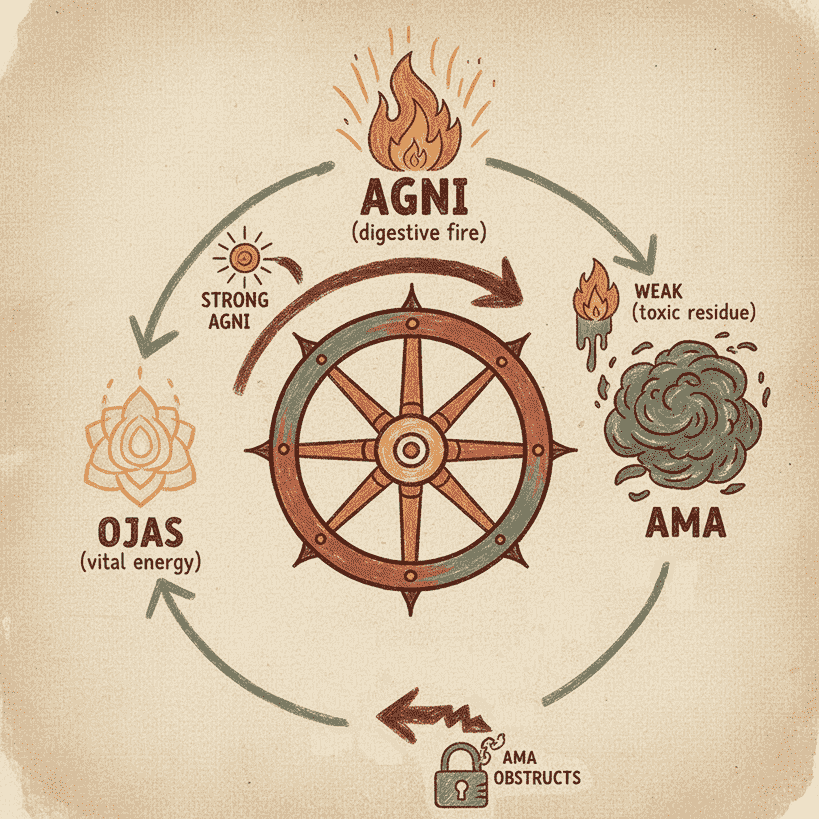
Ayurvedic Process of Digestion, Tissue Nourishment, and Waste Elimination
Food is ingested and transformed by Agni (digestive fire) into Rasa (nutrient plasma), which sequentially nourishes the other body tissues (Saptadhatus). The metabolic process produces waste products (Malas), which are properly eliminated through faeces, urine, and sweat to maintain balance and vitality.
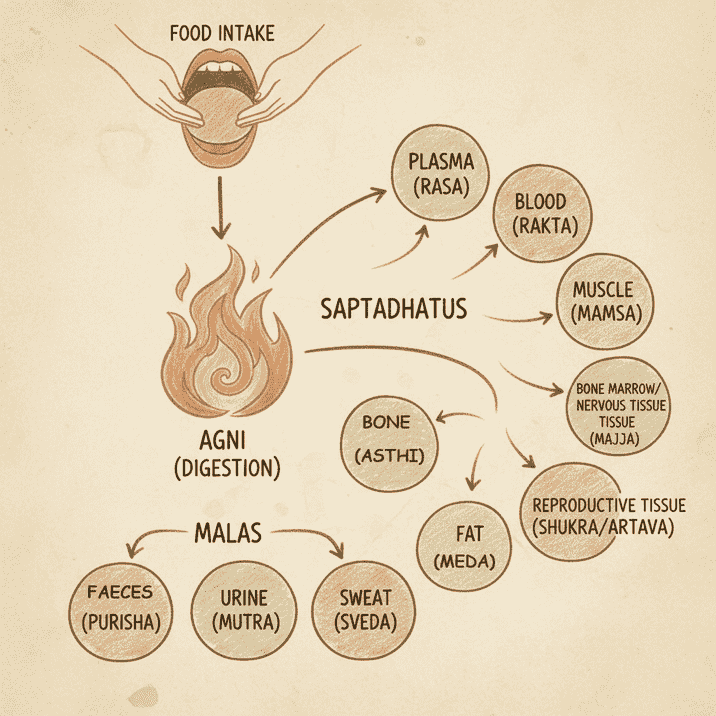
leading to nourishment of Saptadhatus and excretion of Mala
Relationship Between Gunas, Tatvas, and Doshas
Understanding the interconnection between Gunas, Tatvas, and Doshas is crucial to grasp Ayurveda deeply:
- Tatvas carry Gunas: Each element has inherent Gunas that reflect subtle qualities.
- Akasha (Space) is primarily Sattvic, representing expansiveness and purity.
- Vayu (Air) is mostly Rajasic, signifying movement and activity.
- Teja (Fire) embodies both Sattva and Rajas, representing clarity and transformation.
- Jala (Water) combines Sattva and Tamas, indicating fluidity with some inertia.
- Prithvi (Earth) is largely Tamasic, symbolizing stability and heaviness.
- Tatvas unite to form Doshas : The five elements unite with each other to form the three doshas. For example, Vata dosha arises from air and ether, Pitta from fire and water, and Kapha from water and earth.
- Doshas inherit Gunas: Because doshas are formed by elements, their qualities reflect those of their Tatvas.
- Vata is mainly Rajasic with some Sattva, driving movement and nerve impulses.
- Pitta is Sattvic with Rajas, enabling metabolism and intelligence.
- Kapha is Tamasic with some Sattva, ensuring structure and lubrication.
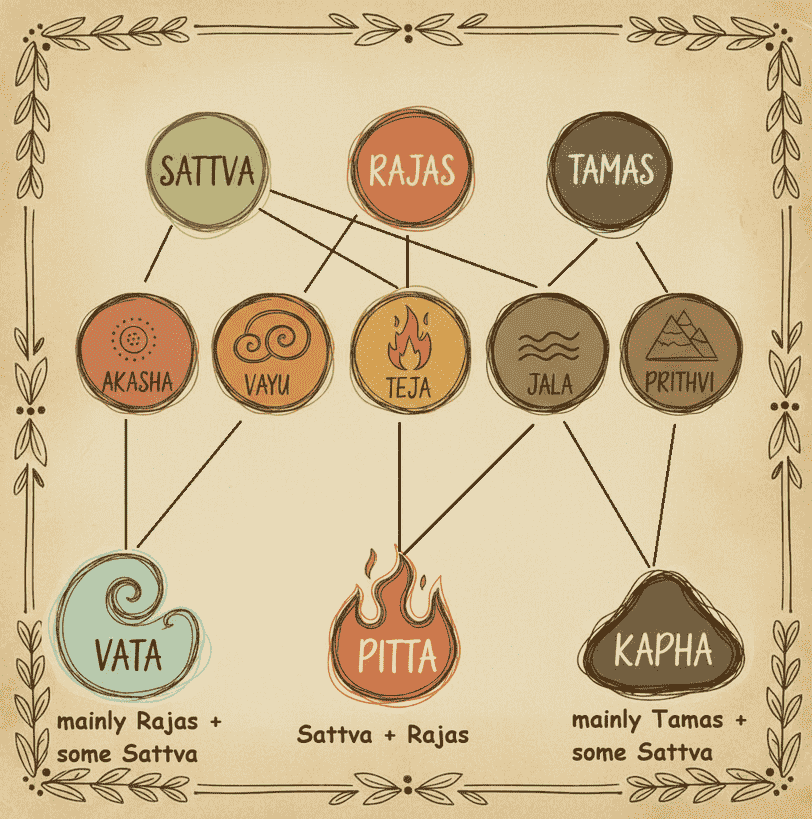
Notice how Doshas inherit Gunas from Tatvas
Functional implications:
- Vata controls respiration, circulation, motion and neural activity.
- Pitta governs digestion, metabolism, and body temperature.
- Kapha maintains stability, immunity, and lubrication.
Mind-body perspective: Gunas primarily describe mental tendencies, whereas Doshas relate to physical functioning. Their interaction provides a complete picture of body-mind health and disease susceptibility.
Holistic Approach of Ayurveda
Ayurveda’s principles emphasize that life is a delicate balance of body, mind, and spirit in harmony with the environment. True health is not just the absence of disease, but a dynamic state marked by:
- Balance of Doshas.
- Optimal functioning of Agni and tissues.
- Effective elimination of waste products.
- A calm and balanced mental state governed by the Gunas.
To maintain this equilibrium, Ayurveda prescribes:
- Personalized diets and lifestyles tailored to one’s Prakriti.
- Herbal therapies for balancing Doshas.
- Yoga and meditation for harmonizing Gunas.
- Seasonal and daily routines aligned with natural rhythms.
Final Thoughts
Ayurveda’s foundational principles—Trigunas, Panchamahabhutas (Tatvas), Tridoshas, and Prakriti—offer a comprehensive framework for understanding life, health, and disease. The Gunas describe mental qualities, the Tatvas form the material foundation, the Doshas represent functional energies, and Prakriti highlights individual constitutional uniqueness.
Together, they create a holistic system that emphasizes harmony, disease prevention, and natural wellness. By grasping the deep connection among Gunas, Tatvas, Doshas, and Prakriti, Ayurveda provides timeless guidance for balanced living, longevity, and well-being.
Refrences:



